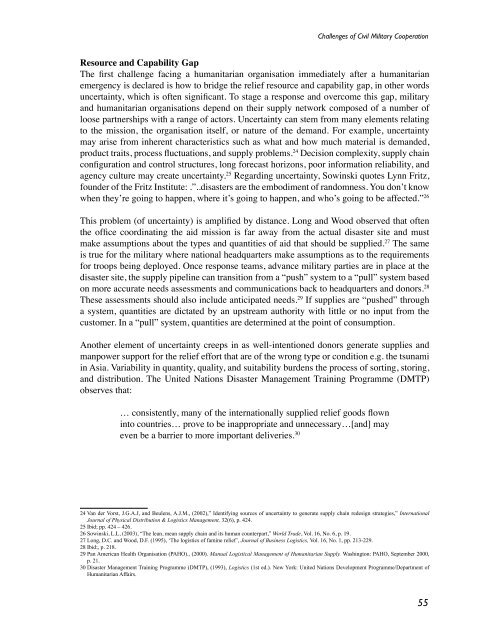Defence Forces Review 2010
Defence Forces Review 2010
Defence Forces Review 2010
Create successful ePaper yourself
Turn your PDF publications into a flip-book with our unique Google optimized e-Paper software.
Challenges of Civil Military CooperationResource and Capability GapThe first challenge facing a humanitarian organisation immediately after a humanitarianemergency is declared is how to bridge the relief resource and capability gap, in other wordsuncertainty, which is often significant. To stage a response and overcome this gap, militaryand humanitarian organisations depend on their supply network composed of a number ofloose partnerships with a range of actors. Uncertainty can stem from many elements relatingto the mission, the organisation itself, or nature of the demand. For example, uncertaintymay arise from inherent characteristics such as what and how much material is demanded,product traits, process fluctuations, and supply problems. 24 Decision complexity, supply chainconfiguration and control structures, long forecast horizons, poor information reliability, andagency culture may create uncertainty. 25 Regarding uncertainty, Sowinski quotes Lynn Fritz,founder of the Fritz Institute: .”..disasters are the embodiment of randomness. You don’t knowwhen they’re going to happen, where it’s going to happen, and who’s going to be affected.” 26This problem (of uncertainty) is amplified by distance. Long and Wood observed that oftenthe office coordinating the aid mission is far away from the actual disaster site and mustmake assumptions about the types and quantities of aid that should be supplied. 27 The sameis true for the military where national headquarters make assumptions as to the requirementsfor troops being deployed. Once response teams, advance military parties are in place at thedisaster site, the supply pipeline can transition from a “push” system to a “pull” system basedon more accurate needs assessments and communications back to headquarters and donors. 28These assessments should also include anticipated needs. 29 If supplies are “pushed” througha system, quantities are dictated by an upstream authority with little or no input from thecustomer. In a “pull” system, quantities are determined at the point of consumption.Another element of uncertainty creeps in as well-intentioned donors generate supplies andmanpower support for the relief effort that are of the wrong type or condition e.g. the tsunamiin Asia. Variability in quantity, quality, and suitability burdens the process of sorting, storing,and distribution. The United Nations Disaster Management Training Programme (DMTP)observes that:… consistently, many of the internationally supplied relief goods flowninto countries… prove to be inappropriate and unnecessary…[and] mayeven be a barrier to more important deliveries. 3024 Van der Vorst, J.G.A.J, and Beulens, A.J.M., (2002),” Identifying sources of uncertainty to generate supply chain redesign strategies,” InternationalJournal of Physical Distribution & Logistics Management, 32(6), p. 424.25 Ibid; pp. 424 – 426.26 Sowinski, L.L, (2003), “The lean, mean supply chain and its human counterpart,” World Trade, Vol. 16, No. 6, p. 19.27 Long, D.C. and Wood, D.F. (1995), ‘The logistics of famine relief’, Journal of Business Logistics, Vol. 16, No. 1, pp. 213-229.28 Ibid;, p. 218.29 Pan American Health Organisation (PAHO)., (2000). Manual Logistical Management of Humanitarian Supply. Washington: PAHO, September 2000,p. 21.30 Disaster Management Training Programme (DMTP), (1993), Logistics (1st ed.). New York: United Nations Development Programme/Department ofHumanitarian Affairs.55
















